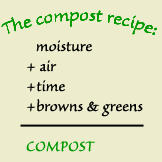
Composting
Composting is the biological decomposition of organic waste such as food or plant material by bacteria, fungi, worms and other organisms under controlled aerobic (occurring in the presence of oxygen) conditions. The end result of composting is an accumulation of partially decayed organic matter called humus. Composting with worms, also known as vermiculture, results in nutrient-loaded worm castings.
Why compost?
- it's easy
- creates a useful soil enricher
- environmentally sound way of reducing yard waste by recycling it where it is generated
Some states, including Florida, have
banned yard wastes from landfills because it takes up space. Yard waste is such materials as leaves, grass clippings, brush and prunings. Leaves and grass clippings can also be used as mulch in your garden or landscape. Yard waste that will be picked up should be bundled or bagged. It will be mulched and
available for free at the Bass Road facility.
How does composting work?
Step 1: Choosing the right composting method for you
There are two kinds of composting, bin/pile composting and worm composting (vermiculture). The type of composter used should be the one that best suits your needs and capabilities.
|
Bin/pile composting
- simply throw in organic materials as they become available around your home and yard
|
Worm composting
|
Step 2: Choosing the right location for your compost bin
Consider how you will get the raw materials to the pile and how the finished compost will be moved to the area it will be used. |
Step 3: Decide what to compost
What goes in the bin?
To build a compost pile, simply alternate layers of browns and greens.

|
Greens:
- Vegetable and food scraps
- Fresh grass clippings and yard waste
- Coffee gounds
- Tea bags
- Egg shells
|
Browns:
- Dried leaves, grass, mulch or hay
- Cardboard rolls
- Sawdust
- Lint
- Newspaper (shredded)
- Fireplace ashes
- Hair/fur
- Clean paper
- Wool/cotton rags
|
Avoid:
- Egg yolks (attracts vermin)
- Meat (attracts flies and rodents)
- Oils, grease (produce odor, attracts vermin)
- Pesticides (can kill composting organisms)
- Pet waste (can carry disease, attract flies
|
|
Step 4: The composting process
The compost pile should be periodically mixed to incorporate oxygen. Regularly check the internal temperature and turn over the mixture when it reaches 140° F.The compost pile should be built in layers 3-4 inches deep. Composting still happens if the pile is not turned, it just breaks down slowly. |
Step 5: Using compost around your home
Once the composting process is complete, the result is a dark, nutrient-rich humus that has many uses:
- Use it as a soil amendment and work a 1-3 inch layer into the garden soil.
- Use it as mulch and apply a 2-3 inch layer on top of the existing soil.
- Use it as a potting mix and blend it with potting soil for container plants.
|



